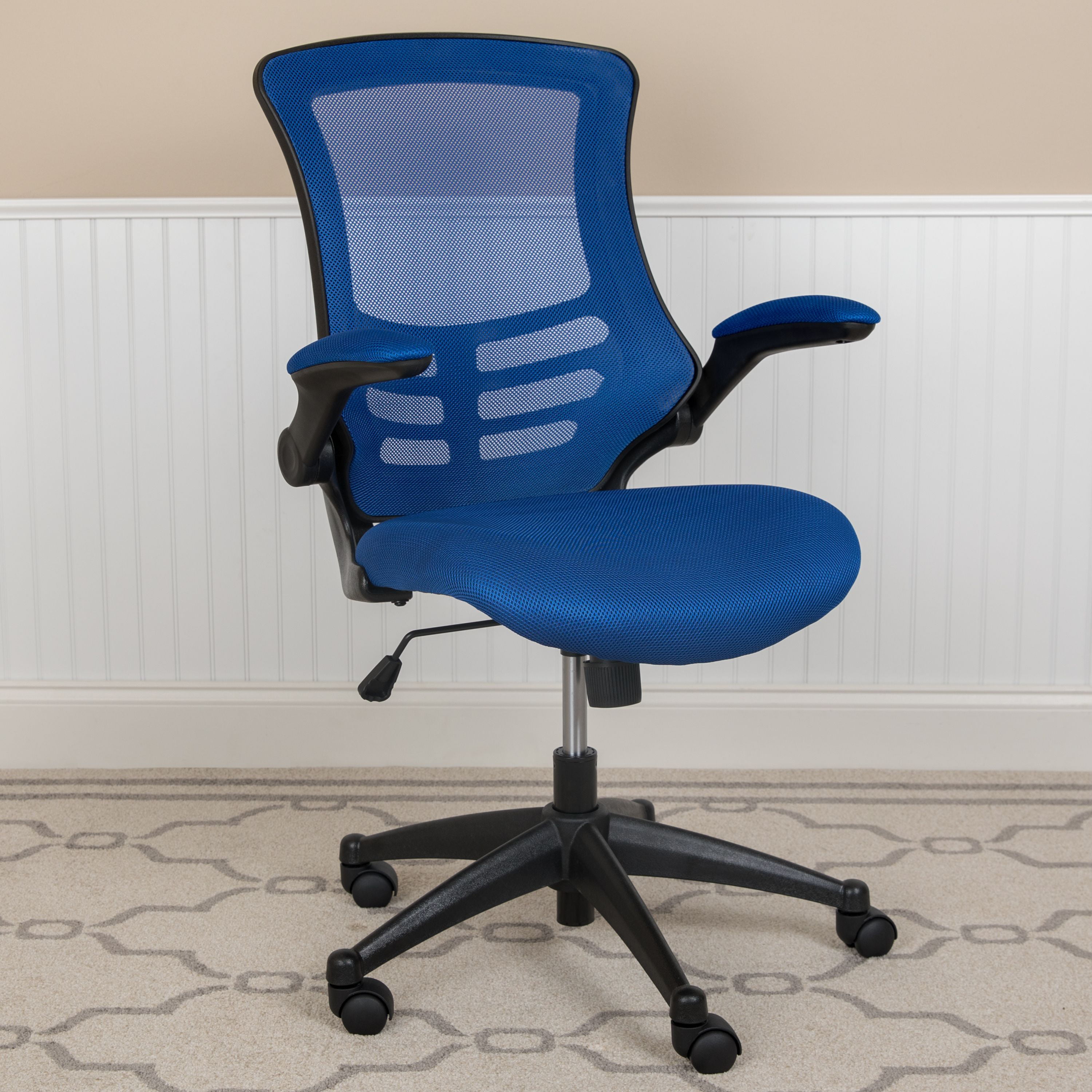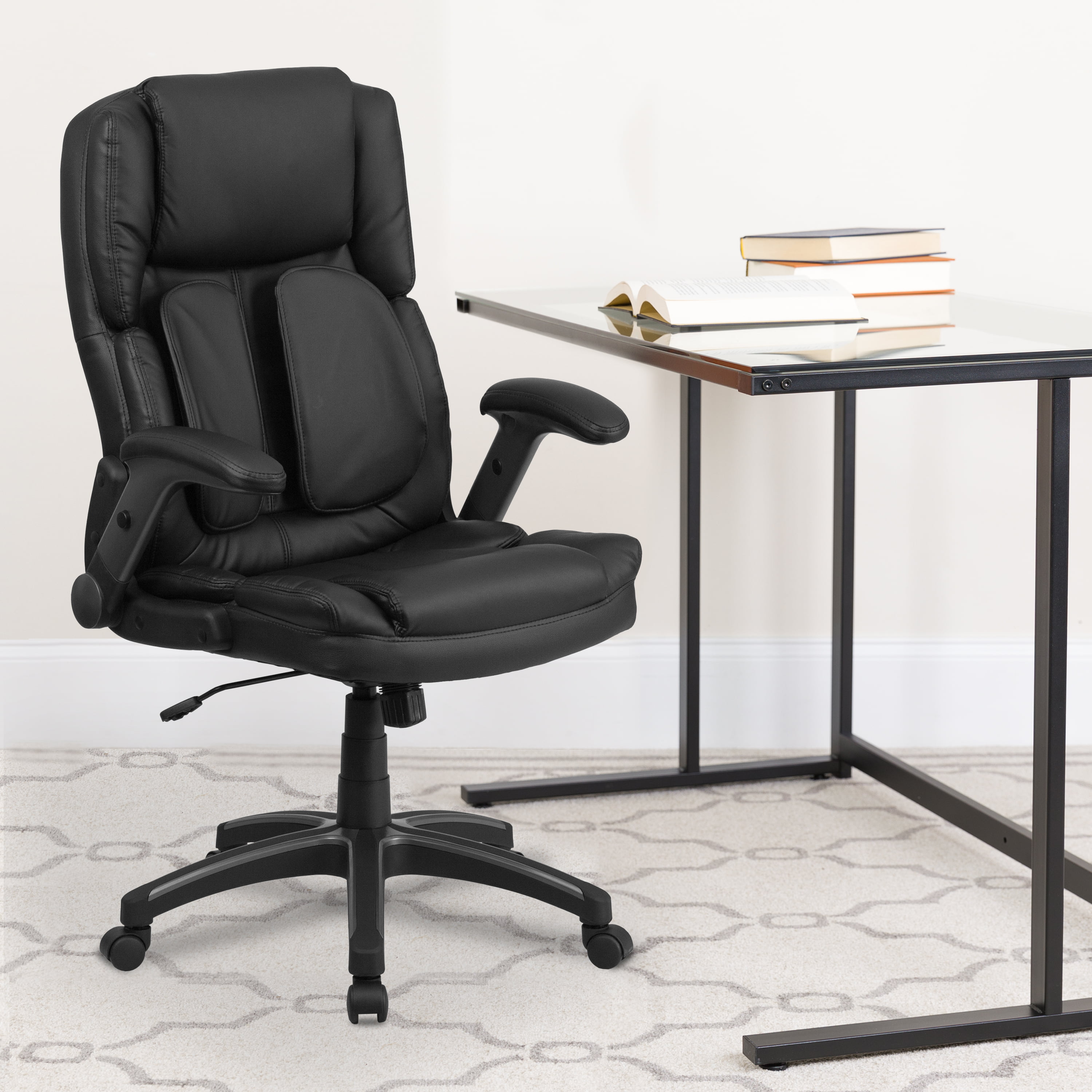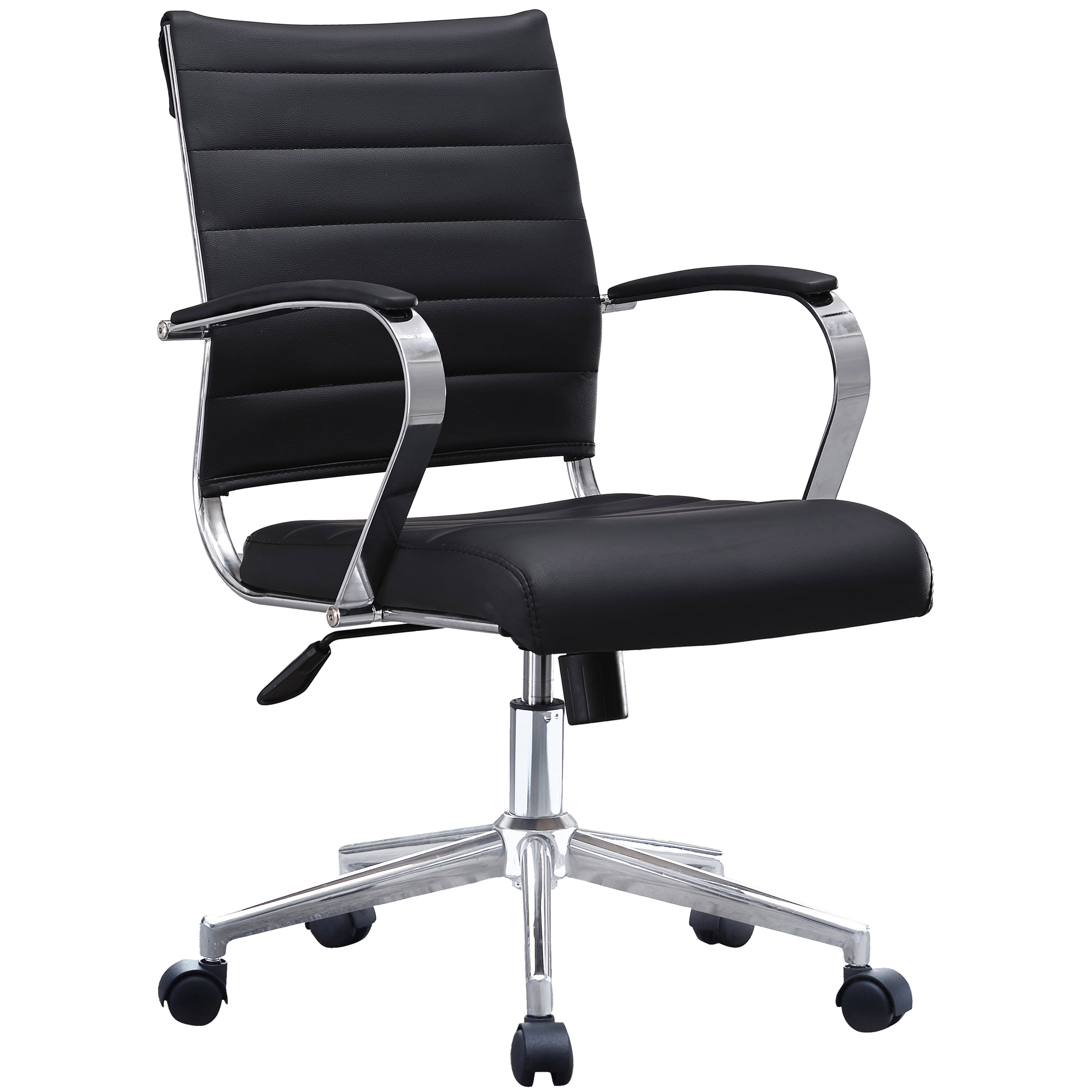Top Features of Swivel Desk Chairs: Stationary Desk Chair That Swivels

Ah, the swivel desk chair – a throne of productivity, a haven for the hardworking, a silent witness to countless hours spent staring at spreadsheets (or cat videos, we don’t judge). But not all swivel chairs are created equal. Let’s delve into the glorious details that elevate a simple chair to a masterpiece of ergonomic excellence.
Adjustable Lumbar Support Mechanisms
Proper lumbar support is the cornerstone of a comfortable and healthy sitting experience. A poorly supported lower back can lead to aches, pains, and a general feeling of “Why am I even alive?”. Adjustable lumbar support allows you to customize the chair to perfectly cradle your spine’s natural curvature, preventing slouching and promoting good posture. The devil, however, is in the details of the mechanism.
| Lumbar Support Type | Mechanism | Adjustability | Pros & Cons |
|---|---|---|---|
| Pneumatic Pump | Inflatable air bladder | High | Precise adjustment, comfortable, can lose air over time. |
| Adjustable Lumbar Pad | Removable or height-adjustable pad | Medium | Easy to adjust, less precise than pneumatic, may not fit all back shapes. |
| Contoured Backrest | Built-in curvature | Low | Simple, less adjustable, may not be suitable for all body types. |
| Dynamic Lumbar Support | Mechanism that moves with the user | High | Excellent support during movement, more complex and expensive. |
Wheel Types and Their Impact
The humble wheel, often overlooked, plays a surprisingly significant role in the swivel chair experience. Choosing the wrong wheels can lead to frustration, floor damage, and even the dreaded chair-stuck-in-the-carpet scenario.
- Carpet Casters: Designed for carpeted surfaces, these usually feature larger wheels and softer materials to prevent damage to carpets. They may, however, roll less smoothly on hard floors.
- Hard Floor Casters: These casters have smaller, harder wheels that roll effortlessly on hard surfaces like wood or tile. They are generally less forgiving on carpets, potentially leaving marks or damaging carpet fibers.
- Universal Casters: Attempting to conquer all surfaces, these often compromise on performance. They may be decent on both but not truly excellent on either.
Swivel Mechanisms: A Comparison
The swivel mechanism is the heart of a swivel chair, allowing for effortless rotation and a dynamic work environment. But not all swivels are created equal; some are smoother than others, some offer more control.
| Swivel Type | Mechanism | Features | Pros & Cons |
|---|---|---|---|
| Smooth Swivel | Ball bearing or similar | 360-degree rotation | Effortless rotation, can be prone to wear over time if not high quality. |
| Tilt Mechanism | Allows for reclining | Adjustable tilt tension | Added comfort and ergonomic benefits, adds complexity and cost. |
| Tilt-Lock Mechanism | Allows for locking the tilt position | Fixed or adjustable angles | Greater stability for focused work, can be less comfortable for extended periods without adjustment. |
| Synchronous Tilt | Seat and backrest move in a coordinated manner | Adjustable tilt tension | Excellent ergonomic support, complex and usually more expensive. |
Material Selection: Comfort, Breathability, and Durability, Stationary desk chair that swivels
The material of your chair significantly impacts its comfort, breathability, and longevity. Choosing the right material is a delicate balance between luxury and practicality.
| Material | Comfort | Breathability | Durability |
|---|---|---|---|
| Mesh | Generally comfortable, especially in warmer climates | Excellent breathability | Moderately durable, can sag over time. |
| Leather | Luxurious and durable feel, can be less breathable | Poor breathability | Highly durable, but can be expensive and requires maintenance. |
| Fabric | Wide range of textures and feels, breathability varies widely | Breathability varies greatly depending on the fabric type | Durability varies widely depending on the fabric type. |
| Faux Leather | Similar feel to leather, more affordable | Poor breathability, similar to leather | Less durable than real leather but more durable than many fabrics. |
Buying Guide for Swivel Desk Chairs

Selecting the perfect swivel desk chair can feel like navigating a minefield of ergonomic jargon and bewildering options. Fear not, intrepid office dweller! This guide will arm you with the knowledge to conquer the chair-choosing battlefield and emerge victorious, seated comfortably in your dream chair. We’ll steer you clear of the pitfalls of poor posture and back pain, ensuring you find a chair that’s as supportive as it is stylish.
Step-by-Step Chair Selection Based on Individual Needs
Choosing the right chair involves considering your unique needs. This isn’t just about aesthetics; it’s about investing in your comfort and long-term well-being. A poorly chosen chair can lead to backaches, neck strain, and even reduced productivity. Let’s avoid that scenario with this straightforward approach.
- Assess Your Body Type: Are you petite, average, or on the taller side? Consider your weight and build. A chair that’s too small will be uncomfortable, while one that’s too large might feel cumbersome and unstable. Think of Goldilocks – you’re looking for that “just right” fit.
- Analyze Your Work Style: Do you spend hours hunched over a keyboard, or do you frequently stand up and move around? A chair designed for long periods of sitting will differ significantly from one suited for more dynamic work habits. A gamer might need more lumbar support and adjustability than a writer, for instance.
- Establish Your Budget: Swivel desk chairs range dramatically in price. Set a realistic budget before you begin your search. Remember, investing in a high-quality chair is an investment in your health and comfort; however, there are excellent options available at various price points.
- Prioritize Key Features: Once you’ve considered your body type, work style, and budget, it’s time to focus on the specific features that matter most to you. This includes factors like adjustability, lumbar support, and material. We’ll cover this in more detail in the next section.
- Test Before You Buy (If Possible): If you can, try out different chairs in person before committing to a purchase. Sit in them for a while to get a feel for the comfort and support. This is the ultimate test, allowing you to experience the chair’s ergonomics firsthand.
Essential Features Checklist
Before you unleash your credit card, take a moment to check off these essential features. Think of this as your pre-flight checklist before embarking on the exciting journey of chair ownership.
- Adjustability: Height adjustment is crucial, allowing you to position your feet flat on the floor and your thighs parallel to the ground. Armrest adjustability can reduce shoulder strain, while backrest adjustability allows for customized lumbar support.
- Lumbar Support: This is non-negotiable for long hours of sitting. Good lumbar support promotes proper spinal alignment and reduces back pain.
- Material: Consider the durability and comfort of the materials used. Mesh is breathable, leather is luxurious (but can be pricey), and fabric offers a range of options. Think about how easy each material is to clean.
- Base and Wheels: A sturdy base and smooth-rolling wheels are essential for stability and easy movement. Look for a five-star base for optimal support.
- Warranty: A good warranty indicates the manufacturer’s confidence in their product. Check the warranty details before purchasing.
Workspace Measurement and Chair Placement
Proper chair placement is crucial for optimal comfort and productivity. Avoid the ergonomic equivalent of a car crash by measuring your workspace meticulously.
Imagine a simple diagram: your desk is a rectangle, and you are sitting in your chair facing it. The chair should be positioned so that your elbows are at a 90-degree angle when typing and your thighs are parallel to the floor. Your feet should rest flat on the floor or a footrest. The monitor should be positioned at arm’s length, with the top of the screen at or slightly below eye level. This ensures a neutral posture and minimizes strain. A second diagram could illustrate the ideal distance between the chair and the desk, ensuring sufficient legroom and preventing the desk from interfering with the chair’s swivel function.
Maintaining and Cleaning Different Chair Materials
Regular maintenance is key to extending the life of your chair. Treat your chair like the loyal steed it is, and it will serve you well for years to come.
- Leather: Condition leather regularly with a leather conditioner to keep it supple and prevent cracking. Clean spills immediately with a damp cloth. Avoid harsh chemicals.
- Fabric: Vacuum regularly to remove dust and debris. Spot clean spills with a mild detergent and water solution. Always test cleaning solutions on an inconspicuous area first.
- Mesh: Mesh is generally easy to clean. Wipe it down with a damp cloth and mild detergent. Allow it to air dry completely.
Swivel Desk Chair Styles and Designs

Choosing the right swivel desk chair is a momentous occasion, akin to selecting a loyal steed for your daily quest of conquering spreadsheets and emails. The style and design of your chair aren’t just about aesthetics; they directly impact your comfort, productivity, and overall office ambiance. Let’s delve into the delightful world of swivel chair styles.
Swivel Desk Chair Style Comparison
The following table compares and contrasts various swivel desk chair design styles. Remember, the “best” style is entirely subjective – it depends on your personal taste and workspace needs. Think of it like choosing between a trusty Labrador and a sophisticated Siamese cat; both are wonderful companions, but cater to different preferences.
| Style | Description | Pros | Cons |
|---|---|---|---|
| Modern | Clean lines, minimalist design, often featuring sleek materials like metal and leatherette. | Stylish, versatile, often durable. | Can be less comfortable for extended periods, potentially lacking in ergonomic features. |
| Traditional | Ornate details, classic silhouettes, typically using wood and fabric upholstery. | Elegant, timeless appeal, can offer superior comfort with proper cushioning. | May be less adaptable to modern office spaces, can be more expensive. |
| Ergonomic | Designed with comfort and posture in mind, incorporating features like lumbar support, adjustable height, and armrests. | Promotes good posture, reduces back pain, improves productivity. | Can be more expensive, may have a less aesthetically pleasing design compared to other styles. |
| Contemporary | Blends modern and traditional elements, often incorporating unique materials and textures. | Versatile, stylish, can offer a balance of comfort and aesthetics. | Finding the right balance of style and comfort can be challenging, price can vary greatly. |
Key Design Elements Affecting Aesthetics and Comfort
The aesthetic appeal and comfort of a swivel desk chair are determined by a harmonious blend of several key design elements. Think of it as a delicious cake – each ingredient contributes to the overall deliciousness.
Stationary desk chair that swivels – The following elements play a crucial role:
- Upholstery Material: The fabric or leather used significantly impacts both the chair’s feel and its visual appeal. Leather offers a sophisticated look but can be less breathable; fabric provides more breathability but might require more maintenance.
- Base and Legs: The base (typically five-star) and legs are foundational to the chair’s stability and visual impact. A sleek metal base offers a modern look, while a wooden base contributes to a more traditional feel.
- Backrest Design: The shape and height of the backrest influence comfort and posture. A high backrest provides better lumbar support, while a low backrest offers more freedom of movement.
- Armrests: Armrests can enhance comfort but should be carefully considered. Adjustable armrests are preferable, offering greater versatility and ergonomic support. Consider the chair’s overall style when selecting armrest designs.
- Cushioning: The type and amount of cushioning affect the chair’s comfort level. High-density foam offers superior support and durability compared to thinner, less dense options.
Color and Material Choices for Visually Appealing Workspaces
Color and material choices are essential for creating a workspace that’s both visually appealing and functional. This isn’t just about choosing your favorite shade; it’s about creating a cohesive and inspiring environment. Think of it as curating an art gallery for your productivity.
| Office Style | Color Palette | Material Suggestions | Example |
|---|---|---|---|
| Modern Minimalist | Neutral tones (white, gray, beige) accented with a bold color (e.g., teal, mustard yellow). | Metal, leatherette, glass. | A white desk paired with a gray leatherette chair and teal accents. |
| Traditional | Warm earth tones (brown, beige, cream) with dark wood accents. | Wood, fabric (velvet, linen), leather. | A dark wood desk with a brown leather chair and cream-colored accessories. |
| Contemporary | Mix of bold colors and neutrals, often incorporating metallic accents. | Variety of materials – wood, metal, fabric, leather. | A dark gray desk with a mustard yellow fabric chair and copper accents. |
| Industrial | Darker tones (black, gray, brown) with metallic accents. | Metal, wood, exposed concrete (if applicable). | A black metal desk with a black leather chair and exposed brick walls. |
